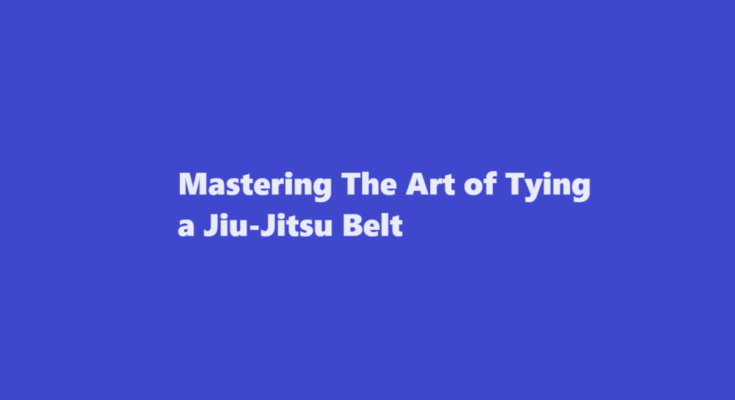Jiu-Jitsu, a martial art that emphasizes technique and leverage over brute strength, places a strong emphasis on tradition and discipline. One of the first lessons a Jiu-Jitsu practitioner learns is how to tie their belt properly. While it may seem like a simple task, tying a Jiu-Jitsu belt is an essential skill that carries deeper meaning within the martial art. In this article, we will delve into the steps and significance of tying a Jiu-Jitsu belt in 700 words.
The Anatomy of a Jiu-Jitsu Belt
Before diving into the tying process, it’s important to understand the anatomy of a Jiu-Jitsu belt. Typically, Jiu-Jitsu belts are made from cotton or a similar fabric. They are long and narrow, with a standard width of 1.5 to 2 inches. The color of the belt indicates a practitioner’s rank and progress within the art. Beginners usually start with a white belt and progress through various colors, including blue, purple, brown, and finally, black.
The Steps to Tying a Jiu-Jitsu Belt
- Hold the Belt Begin by holding both ends of the belt in your hands. Ensure that the belt is centered, with an equal length of fabric on both sides.
- Wrap Around Your Waist Place the center of the belt against your waist, just below your belly button. Hold the ends of the belt in front of you and cross them over your back, making sure the belt is snug against your waist.
- Cross the Ends With one end in each hand, cross the right end over the left end. This creates an “X” shape at the front of your waist.
- Tuck the Right End Under Take the end that’s now on the right side and tuck it under both layers of the belt that are wrapped around your waist. This will create a loop on the right side.
- Tighten the Knot Pull both ends of the belt tight to secure the knot. Make sure the belt is snug but not overly tight. You should still be able to comfortably breathe and move.
- Adjust the Ends Ensure that the ends of the belt are of equal length and hanging down evenly. The belt should be neatly folded and not twisted.
- Final Adjustments Make any final adjustments to the knot and belt as needed to ensure it is comfortable and secure. The ends of the belt should hang down evenly and not obstruct your movement.
The Significance of Tying a Jiu-Jitsu Belt
Tying a Jiu-Jitsu belt is not just about fastening a piece of fabric around your waist; it carries deep symbolism within the martial art. Here are some of the key aspects of its significance
- Respect for Tradition Tying a Jiu-Jitsu belt is a tradition that dates back to the origins of the martial art in Japan. It pays homage to the rich history and lineage of Jiu-Jitsu.
- Hierarchy and Progress The color of the belt represents a practitioner’s rank and progress within Jiu-Jitsu. It signifies their level of expertise, dedication, and commitment to the art. Each promotion to a higher belt color is a significant achievement.
- Humble Beginnings Every Jiu-Jitsu practitioner starts as a white belt, symbolizing purity and a blank slate. Tying a white belt represents the beginning of a journey toward mastery.
- Discipline and Attention to Detail The process of tying a Jiu-Jitsu belt teaches discipline and attention to detail. A neatly tied belt reflects a practitioner’s commitment to excellence in both their technique and their approach to life.
- Equality and Camaraderie Regardless of one’s rank, every practitioner ties their belt in the same way. This emphasizes the sense of equality and camaraderie within the Jiu-Jitsu community, where everyone is a student continuously learning and improving.
- Focus and Mindfulness Tying a Jiu-Jitsu belt can be a moment of meditation and focus. It’s a time to clear the mind, set intentions, and prepare for training or competition.
FREQUENTLY ASKED QUESTIONS
Does it matter how you tie your belt in BJJ?
Step-By-Step Guide on How to Tie BJJ Belts. There are various methods of tying your BJJ belt. Some fighters prefer having a tight belt around their waits, but those who like playing with the gi’s lapel prefer the belt loose.
Which fingers should I tape BJJ?
Also, even though you might have only one finger injured we advise you to tape at least the two fingers next to the damaged one in order to fortify the whole hand. You will find that with this your grip will be stronger and there will be a lot less pressure on the joints.
In conclusion, tying a Jiu-Jitsu belt may seem like a simple act, but it carries profound meaning within the martial art. It represents tradition, discipline, hierarchy, and a commitment to continuous improvement. Whether you are a beginner with a white belt or an experienced practitioner with a black belt, the act of tying your Jiu-Jitsu belt is a reminder of the values and principles that underlie this ancient and respected martial art. So, next time you tie your belt, remember its significance and the journey it represents.
Read Also : A Step-by-Step Guide – How to Change a Watch Battery



